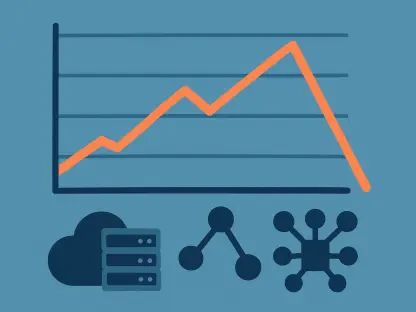In an era marked by rapid technological advancement and increasing global competition, the manufacturing industry faces transformative pressures to optimize processes and boost efficiency. As manufacturing emerges from a phase of contraction, as indicated by the Philadelphia Fed Manufacturing Index, the spotlight shines on digital transformation as a key driver for future growth. The surge in the Philadelphia Fed CAPEX Index to 17.1 underscores the optimistic outlook on capital expenditures, specifically in sectors like software and automation. This optimism, despite an overall negative trend in manufacturing, highlights the confidence industries have in leveraging technology to address challenges and seize emerging opportunities. Attention is now directed towards understanding the implications of digital transformation and adopting AI-driven solutions, Internet of Things (IoT) technologies, and cloud infrastructure to reshape manufacturing.
Embracing Technological Advancements
Manufacturers are increasingly recognizing the strategic value of investing in digital tools. The software diffusion index reveals that nearly 29% of manufacturing firms plan to prioritize digital investments, driven by the integration of AI-driven automation. This trend not only enhances productivity but also positions companies to outperform benchmarks. Key industry players like PTC and Autodesk are experiencing significant gains, attributed to their focus on automation, bolstering investor confidence and market perception. In the realm of industrial automation, corporations such as ABB and Siemens stand poised to capitalize on the growing demand for advanced AI tools and cloud-based solutions. Their strategic positioning offers promising growth avenues, reflecting the broader transition from traditional manufacturing processes to digital and automated solutions.
The shift towards technology is not just about embracing new tools but involves a comprehensive rethinking of manufacturing strategies. The adoption of IoT technologies enables smarter operations, allowing factories to predict equipment failures and optimize maintenance schedules, thereby reducing downtime and enhancing cost efficiency. Enhanced data analytics play a pivotal role in this transformation. By harnessing vast datasets, manufacturers can obtain insights into supply chain efficiencies, market demand fluctuations, and production bottlenecks, thus refining operational strategies. Automation and IoT integration lead to more precise and responsive production schedules, aligning closely with market demands and reducing wastage. These advancements indicate a paradigm shift in the sector, where digital transformation emerges as a catalyst for heightened competitive advantage and sustainability in manufacturing practices.
Sector-Specific Opportunities and Challenges
While digital transformation paves the way for many sectors, the manufacturing landscape reveals sector-specific dynamics. Software and industrial automation sectors lead the charge in growth, but the energy equipment/services sector also presents unique opportunities. The uptick in the New Orders Index for energy-related shipments reflects this, driven by AI-driven drilling analytics that significantly reduce capital expenditures in exploration. Companies like Schlumberger and Halliburton are leveraging these technological advancements to enhance efficiency and sustainability, demonstrating robust adaptability to evolving market needs. Conversely, the energy-saving and structural investment sectors face distinct challenges. The contraction in investment is influenced by manufacturers’ preference for short-term liquidity over long-term projects. With energy-saving and structure indices showing declines, manufacturers exhibit caution in capital-intensive green initiatives. This reflects a broader shift in focus, where immediate financial stability takes precedence.
Consumer Staples also encounter notable hurdles, with 41% of manufacturers reporting reduced production. This is indicative of sectoral margin compression, exacerbated by rising input costs and sensitivity in price-driven consumer markets. The challenges in these sectors highlight the complexities of digital transformation. While technology offers undeniable benefits, the alignment with broader strategic goals and market conditions remains crucial for sustained success. Navigating these dynamics requires a nuanced approach, where strategic adaptability is essential in aligning digital investments with long-term growth and sectoral imperatives. Therefore, while embracing digital transformation, understanding the unique challenges and opportunities within each sector is crucial for companies to maximize growth potential and mitigate risks.
Strategic Risk Mitigation and Future Considerations
In response to the evolving landscape, companies are increasingly focusing on strategic risk mitigation. A balanced approach is crucial, emphasizing investments in high-conviction sectors while maintaining defensive strategies. By prioritizing software and automation exposure, organizations can align with growth sectors and reduce reliance on less stable areas like energy-saving initiatives. The healthcare and utilities sectors present viable avenues for diversification. These sectors offer stability and downside protection, balancing risks with promising opportunities. Healthcare logistics benefit from steady demand, while utility infrastructure provides resilience against market volatility. This diversified strategy allows companies to navigate uncertainty while capitalizing on burgeoning trends in sectors aligned with digital transformation.
Agile strategy formulation is essential in the backdrop of inflationary pressures affecting the manufacturing sector and altering capital allocation priorities. The current economic environment requires a focus on decisive actions that adapt to changing conditions. Informed decision-making, guided by indices like the Philadelphia Fed CAPEX Index, can steer organizations toward effective capital allocation. The insights gained from this index, reflecting evolving market sentiments and trends, serve as a vital tool for strategic planning. By staying ahead of market dynamics and leveraging technological advancements, manufacturers can position themselves advantageously in the industrial landscape. Ultimately, strategic foresight, coupled with digital transformation and sectoral adaptability, forms the cornerstone of success in manufacturing moving forward.
The Road Ahead in Manufacturing
Manufacturers are increasingly valuing digital tools as strategic investments, with the software diffusion index indicating nearly 29% of manufacturing firms plan to focus on digital advancements fueled by AI-driven automation. This trend not only boosts productivity but also helps companies surpass industry benchmarks. Key players like PTC and Autodesk have seen notable gains due to their emphasis on automation, strengthening investor confidence and market reputation. In industrial automation, companies such as ABB and Siemens are well-positioned to tap into the rising demand for sophisticated AI tools and cloud-based solutions, promising growth as the industry shifts from traditional methods to digital and automated processes.
This technological evolution involves rethinking manufacturing strategies beyond merely adopting new tools. Integrating IoT technology leads to smarter operations by enabling factories to predict equipment failures, optimize maintenance schedules, reduce downtime, and enhance cost efficiency. Advanced data analytics offer insights into supply chain efficacy, market demand variability, and production obstacles, refining operations. Automation and IoT advance alignment with market demand and minimize waste, marking a sector shift where digital transformation is a key driver for competitive and sustainable manufacturing.









